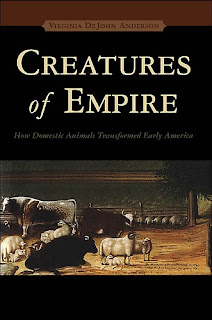In Creatures of Empire: How Domestic Animals Transformed Early America, Virginia Anderson argues that in seventeenth-century Chesapeake and New England, domestic animals put English settlers and Native Americans into close contact and thus actively shaped the history of early America and settler/ native relations. By putting livestock at the center of early American history, Anderson contributes to a growing body of literature in animal studies, which, like environmental history, decenters human historical agency by elevating the broader environmental context. Because colonists and Indians related to animals very differently and because these relationships had a huge impact on the landscape, focusing on animals also allows Anderson to investigate the imposition of one worldview over another in a holistic way.
Anderson divides her book into three sections: a discussion of the many ways Algonquians and English settlers thought about different kinds of animals at the beginning of the 17th century; a history of the introduction of livestock into the Chesapeake colonies and New England and the development of regional husbandry practices; and a comparison of two near-simultaneous conflicts in the 1670s, Bacon's rebellion and King Philip's War, with an emphasis on the relationship between disputes over livestock and the outbreak of violence in both regions. Building on Bill Cronon's Changes in the Land, she argues that the English settlers sought to turn the New World into England, which included imposing their view of animals as property on the landscape and on Native Americans. There were regional differences: Chesapeake farmers, with tobacco as their cash crop, let pigs and other animal run free and go semi-feral; New England farmers, who had to deal with colder climates and rocky soils, ran family farms rather than large plantations, and kept a closer eye on their herds. However, in both regions, Native American responses to new animals and practices ranged from cautious acceptance of pigs (which seemed like deer or dogs) to outright rejection of environmental destruction by animals.
In some ways, this book is a continuation of the spatial turn in American Studies: English attitudes toward animals were closely linked to their attitudes about property, and Algonquian attitudes toward animals were linked to their more holistic view of humans, animals, and the environment, so disputes over animals spatialize and materialize conflicting worldviews. By broadening the concept of agency to include environmental and non-human actors, it also presents a more contextual (and thus possibly more complete and less biased, or at least differently biased) history of early America.

No comments:
Post a Comment